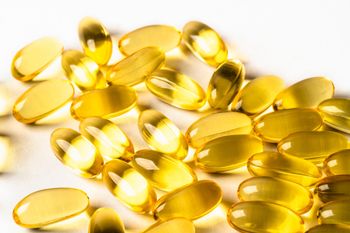
- Nutritional Outlook Vol. 21, No 3
- Volume 21
- Issue 3
Vitamin D Benefits for Pain Management
Studies show vitamin D can be part of an alternative approach to pain therapy.
A significant percentage of the general population suffers from chronic pain due to adverse health issues. Chronic widespread pain (CWP), for instance, can be caused by fibromyalgia and other musculoskeletal conditions. A recent meta-analysis looking at the prevalence of CWP in the general population estimated that 10%-15% of individuals population-wide experience CWP1. Other estimates put the prevalence of chronic pain among older adults at over 40%.2 CWP includes diffuse musculoskeletal pain that is longstanding in nature and often accompanied by other symptoms, including psychological distress, fatigue, and poor concentration.
Standard treatment of CWP and other pain syndromes has largely focused on the use of analgesic and anti-inflammatory drugs, including opioids, which are commonly prescribed3 but which have limited effectiveness and can lead to serious long-term abuse and addiction. Opioids are now the most commonly prescribed class of medications in the United States; however, over a third of drug overdose deaths reported in 2013 were attributable to pharmaceutical opioids. The rate of opioid addiction has also skyrocketed in recent years, with estimates even as far back as 2014 suggesting that addiction impacts upwards of 2.5 million U.S. adults.2 These staggering figures attest to the urgency of better identifying root causes of chronic pain conditions. It also highlights the general appeal of developing pain therapies that are efficacious, yet safe and with reduced potential for abuse.
Mechanisms of Vitamin D in Chronic Pain
Several recent studies have looked at the relationship between pain and vitamin D status. A number of research groups have found that vitamin D deficiency could be linked to higher levels of perceived pain in those suffering from various types of chronic pain conditions. Others are looking to see whether supplementation with vitamin D can decrease pain experienced by long-term sufferers. Observational studies have found a high prevalence of vitamin D deficiency or insufficiency in those suffering from chronic pain4, and estimates by some investigators based on an analysis of 2005-2006 data from the National Health and Nutrition Examination Survey (NHANES) suggest that nearly 42% of U.S. adults are vitamin D deficient.5 According to NHANES, vitamin D deficiency is also substantially higher in Hispanics (69%) and blacks (82%).5
Maria Helde-Frankling and Linda Björkhem-Bergman of the Karolinska Institute and Karolinska University Hospital (Stockholm, Sweden) recently authored a review discussing the role of vitamin D in pain management.4 In this review, they highlight the anti-inflammatory effects of vitamin D in the body that may lead to a decreased perception of pain when deficiency states are corrected. Vitamin D’s physiological mechanisms include reducing the release of pro-inflammatory cytokines and shifting T-cell responses to favor those that are anti-inflammatory rather than pro-inflammatory in nature. Vitamin D has been shown to inhibit the synthesis of prostaglandin E2, an important factor in inflammatory pain. Further studies have found that vitamin D administration resulted in the downregulation of TNF-alpha and leukotriene B4, also pain-related cytokines.
Vitamin D and Pain: Clinical Effects
In recent years, several clinical studies have been performed to assess the potential benefits of vitamin D supplementation for chronic pain associated with various causes. While not all studies have had positive results, several have shown a beneficial impact of vitamin D.
A recent study by Babita Ghai and colleagues from the Postgraduate Institute of Medical Education and Research (Chandigarh, India) looked at vitamin D supplementation in individuals with chronic lower back pain.6 In the open-label study, 68 adults with chronic low back pain greater than 3 months in duration and plasma 25-hydroxyvitamin D3 levels less than 30 ng/ml (a level commonly considered vitamin D insufficient) were supplemented with 60,000 IU of vitamin D3 weekly for eight weeks and followed for 6 months.
The mean vitamin D level at baseline was 12.8 ng/ml in the patient population, but supplementation increased vitamin D levels to 36.07 ng/ml at the end of eight weeks. Average scores for pain assessed on a visual analog scale (VAS) at baseline were 81. These scores decreased progressively over the supplementation and follow-up period to averages of 61, 45, and 36 at 2, 3, and 6 months, respectively. There was a corresponding significant improvement in physical function at all three time points as well, indicating that vitamin D repletion and supplementation may be effective for reducing pain and improving functional ability in those with chronic lower back pain.
In an earlier published study, Turkish researchers evaluated 83 women suffering from chronic widespread pain by assessing the association of pain with vitamin D status.7 Women with an average age greater than 50 were included in the study and divided into two groups based on serum 25-hydroxyvitamin D3 levels either above or below the cutoff for deficiency of 20 ng/ml. Based on this cutoff, 50 patients were assigned to the low–vitamin D group, and 33 were assigned to the normal–vitamin D group. Subjects were then assessed for pain using a VAS score, verbal rating scale (six words denoting pain intensity ranging from no pain to unbearable pain), and face pain scale (visual diagrams representing six different faces with expressions ranging from smiling to crying). The Nottingham Health Profile was included to evaluate quality of life, while nerve conduction studies were also conducted.
Those with low vitamin D levels had significantly higher pain intensity on all scales and a decreased quality of life when compared to those with normal vitamin D status, highlighting the association of chronic pain with vitamin D deficiency.
As a follow on to the initial investigation, the same research group performed an intervention study in vitamin D–deficient women suffering from chronic widespread pain. During the study, 33 women with 25-hydroxyvitamin D levels below 10 ng/ml were given vitamin D at a dose of 50,000 IU/week for eight weeks, followed by a maintenance dose of 2,000 IU/day.8 Pain was assessed using the same scales as the original study, and quality of life was measured using the Nottingham Health Profile. Nerve conduction studies were also performed.
Vitamin D levels improved from an average of 6.69 ng/ml at baseline to 42.94 ng/ml after eight weeks of supplementation. All pain measures decreased significantly from baseline to eight weeks, while Nottingham Profile scores, including the pain, emotional reactions, and physical function subscores, showed significant reductions, indicating improvements in quality of life. Nerve conduction studies showed no significant differences from baseline values; however, overall, the pilot study indicated the benefits of vitamin D repletion on several indicators of chronic pain.
In another study, researchers from Tel-Aviv University (Tel-Aviv, Israel) randomized 74 adults aged 18 and older suffering from chronic musculoskeletal pain greater than 6 months in duration into two groups; one received 4,000 IU vitamin D per day for 12 weeks, while the other group received a placebo.9 Patients were already receiving their regular analgesic regimen at the time of inclusion, and vitamin D status measurements found that 73% were insufficient at baseline (defined as concentrations lower than 30 ng/ml).
Visual analog scale scores for pain decreased significantly from baseline in the vitamin D–supplemented group at week 6 and week 12, while no such significant changes were noted with placebo. Serum inflammatory markers, including TNF-alpha and prostaglandin E2, showed decreases in the vitamin D group by 54% and 39%, respectively, while these values increased in the placebo group by an average of 16% each. The need for analgesic rescue medication was also substantially lower in the vitamin D–supplemented group, indicating potential benefits of vitamin D in those with chronic musculoskeletal pain.
Vitamin D and Inflammation
In addition to the clinical evidence suggesting vitamin D repletion improves parameters of pain associated with chronic conditions, several clinical studies demonstrate its anti-inflammatory effects in a diverse range of health states. Alexander Rodriguez and colleagues from Monash University (Melbourne, Australia) recently conducted a meta-analysis including seven randomized controlled clinical trials which assessed the effect of vitamin D supplementation on inflammatory markers in patients with heart failure.10 While the results of their analysis did not find changes in all inflammatory markers assessed, they showed a significant decrease attributable to vitamin D in the pro-inflammatory cytokine TNF-alpha.
Furthermore, a current study by an Iranian research group looked to evaluate the anti-inflammatory effects of high-dose vitamin D supplementation in adolescent girls.11 In the nine-week study, 580 adolescent girls were asked to supplement with 50,000 IU/week of vitamin D3. C-reactive protein (CRP) and neutrophil-to-lymphocyte ratio were evaluated as markers of systemic inflammation before and after supplementation. The investigators found statistically significant reductions in CRP as well as neutrophil count at the end of the study, indicating vitamin D’s ability to reduce systemic inflammation.
Another model of chronic inflammation in which vitamin D has been investigated is inflammatory bowel disease. Led by Amrollah Sharifi, a group from Tehran University of Medical Sciences (Tehran, Iran) conducted a randomized placebo-controlled trial to evaluate the effects of vitamin D3 on inflammation in ulcerative colitis patients.12 Ninety individuals with ulcerative colitis who were in remission received an intramuscular dose of 300,000 IU vitamin D3 or a saline placebo and were evaluated at baseline and after 90 days. The results of the study showed that CRP levels and erythrocyte sedimentation rate (ESR) were both significantly lowered in the vitamin D group at 90 days compared to placebo. Furthermore, vitamin D also resulted in a significantly higher expression of the genes encoding for cathelicidin, an antimicrobial peptide secreted by colonic epithelial cells that is protective of colon health. Thus, vitamin D administration led to a significant anti-inflammatory effect in individuals with ulcerative colitis.
More Research Ahead
Vitamin D is a prohormone-like vitamin that has a broad range of activity in the human body. Several functions are related to its influence and modulation of important aspects of the immune system, particularly key pro-inflammatory cytokines. Downregulation of these cytokines leads to systemic anti-inflammatory effects. Ensuring optimal intake of vitamin D through supplementation allows for the repletion of this vitamin and for critical physiological processes to function well.
Since the prevalence of chronic pain syndromes is so high amongst the general population-and the prevalence of vitamin D insufficiency is concomitantly high, especially in these individuals-vitamin D supplementation seems like a no-brainer, as well as a critical first step in ensuring the body is wired to deal with the pain it is suffering by balancing out the inflammatory process. While vitamin D may not be the answer or an alternative to highly addictive pain medications all by itself, supporting the body’s normal physiology by ensuring it has all the necessary building blocks can allow it to return to its natural healthy state and likely lessen the need for more drastic interventions.
Also read:
References:
- Mansfield KE et al., “A systematic review and meta-analysis of the prevalence of chronic widespread pain in the general population,” Pain, vol. 157, no. 1 (January 2016): 55–64
- Volkow ND et al., “Opioid abuse in chronic pain-misconceptions and mitigation strategies,” New England Journal of Medicine, vol. 374, no. 13 (March 31, 2016): 1253–1263
- Menzies V et al., “Polypharmacy, opioid use, and chronic widespread pain: a secondary analysis of clinical trial data,” Biological Research for Nursing. Published online July 18, 2016.
- Helde-Frankling M et al., “Vitamin D in pain management,” International Journal of Molecular Sciences, vol. 18, no. 10. Published online October 18, 2017.
- Forrest KYZ et al., “Prevalence and correlates of vitamin D deficiency in US adults,” Nutrition Research, vol. 31, no. 1 (January 2011): 48–54
- Ghai B et al., “Vitamin D supplementation in patients with chronic low back pain: an open label, single arm clinical trial,” Pain Physician, vol. 20, no. 1 (January–February 2017): E99–E105
- Kuru P et al., “Hypovitaminosis D in widespread pain: its effect on pain perception, quality of life and nerve conduction studies,” Rheumatology International, vol. 35, no. 2 (February 2015): 315–322
- Akyuz G et al., “The effect of vitamin D supplementation on pain, quality of life, and nerve conduction studies in women with chronic widespread pain,” International Journal of Rehabilitation Research, vol. 40, no. 1 (March 2017): 76–83
- Gendelman O et al., “A randomized double-blind placebo-controlled study adding high dose vitamin D to analgesic regimens in patients with musculoskeletal pain,” Lupus, vol. 24, no. 4-5 (April 2015): 483–489
- Rodriguez AJ et al., "Effects of vitamin D supplementation on inflammatory markers in heart failure: a systematic review and meta-analysis of randomized controlled trials,” Scientific Reports. Published online January 18, 2018.
- Tabatabaeizadeh SA et al., “High dose supplementation of vitamin D affects measures of systemic inflammation: reductions in high sensitivity C-reactive protein level and neutrophil to lymphocyte ratio (NLR) distribution,” Journal of Cellular Biochemistry, vol. 118, no. 12 (December 2017): 4317–4322
- Sharifi A et al., “A randomized controlled trial on the effect of vitamin D3 on inflammation and cathelicidin gene expression in ulcerative colitis patients,” Saudi Journal of Gastroenterology, vol. 22, no. 4 (July-August 2016): 316–323
Articles in this issue
over 7 years ago
Pet Food Trends: Clean Label, Grains, Health Benefits, and Moreover 7 years ago
New Hidden Stimulants Surface in Sports Dietary Supplementsover 7 years ago
Asia Pacific Is Sports Nutrition’s Next Hot Spotover 7 years ago
Natoli Acquires Carlisle Precision Machining Encapsulationover 7 years ago
Clean Label on the Rise in Sports Nutrition SupplementsNewsletter
From ingredient science to consumer trends, get the intel you need to stay competitive in the nutrition space—subscribe now to Nutritional Outlook.





